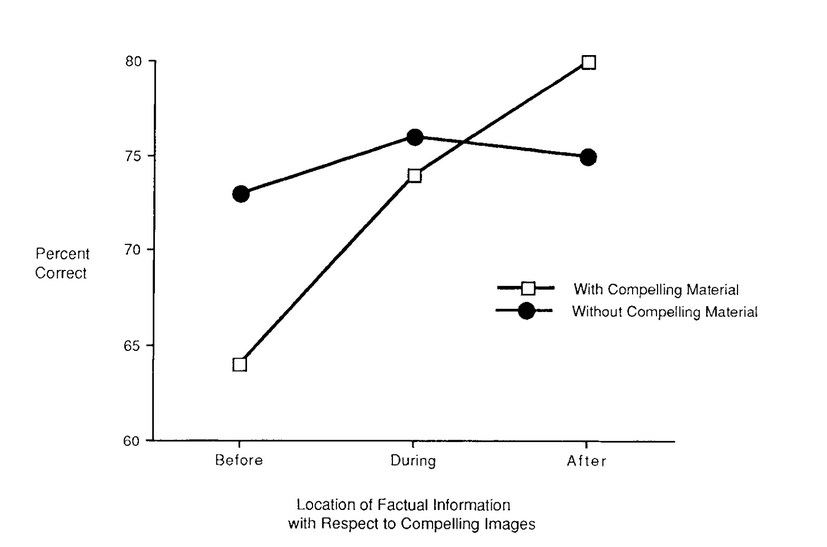Newhagen and Reeves (1992)
 Newhagen and Reeves (1992) wanted to see if emotive images in the news media affect one's ability to recall information about the news story. This study would be appropriate for the HL extension question: Discuss the effect of technology on emotion and cognition.
Newhagen and Reeves (1992) wanted to see if emotive images in the news media affect one's ability to recall information about the news story. This study would be appropriate for the HL extension question: Discuss the effect of technology on emotion and cognition.
Flashbulb memory research claims that strong emotion can lead to vivid memories of events if those events are personally meaningful. Research by McGaugh & Cahill (1995) shows the role that adrenaline may play in the creation of memories. In their study, participants were asked to watch a slideshow. In one version, a young boy was in an accident that led to his legs being severed. In the other version, the boy comes across a movie set where an accident has taken place. A week later, it was found that those that had seen the more disturbing interpretation of the slides had higher rates of recall.
However, this study has been criticized for its artificiality. In the test of memory, the participants were given a forced-choice response in which they were asked specific questions about the slide show. When looking at the results of the study, there was no focus on the information that was seen before the disturbing information and the information seen after the disturbing image.
Newhagen and Reeves (1992) wanted to investigate whether emotive images seen on television would actually impair recall of the details of the event. In addition to looking at overall recall, they would also look at the information that was provided before and after the emotive images were presented.
Newhagen and Reeves (1992) wanted to see if images that led to negative emotional responses affect one’s ability to recall information about news events. For their study, the independent variable was the presence or absence of compelling negative images in television news stories. The dependent variable was the reaction time needed to identify whether the material was relevant to the story they had seen and memory for details in the news stories.
The researchers created two versions of each news story: one with emotion-provoking negative images of the event and one with non-emotive images. News topics included plane crashes, wars, revolutions, riots, famine, sports violence, natural disasters, and reported crimes.
A pilot group was used to measure the intensity of each story. The stories with the greatest difference between the two versions were chosen for the study. Each story was a 2.5 – 3.5 minute video. Each video was altered to have 20 – 30 seconds of compelling (emotion-provoking) or non-compelling (non-emotive) images.
The sample was made up of 56 Stanford undergraduate students (age 19 – 25); the sample was evenly divided between men and women. Each participant viewed 8 news stories. Four of the stories had negative images and four did not. Each participant saw half of the potential 16 stories. The presentation of the videos was altered to avoid order effects.
The researcher explained that each person would watch a 20-minute video with 8 news stories. They were told to pay attention to the news stories because they would be asked questions after the session.
After watching the first video - which showed the 8 news stories - participants were asked to watch a second video. In this video, they were asked to press a yes or no button as fast as they could to decide whether the material was from what they had seen or not.

As you can see from the graph on the left, recognition of factual information was less correct for material before the compelling images than the material before the non-compelling images. It appears that the emotive nature of the images impaired recall of this information.
It appears that there were retroactive effects - that is, the emotional images seem to impair recall of memory before the images, but actually strengthened recall after the image.

Six to seven weeks later, 20 participants completed a follow-up questionnaire. They were first asked to write down as many of the story topics as they could remember. They were asked to write down as many details about those topics as they could remember. Finally, they were given the topics of the eight stories and asked to write down whatever they could remember.
As you can see in the graph to the left, the highly intense images inhibited the encoding of factual information (semantic memories). 6- 7 weeks later, factual information was remembered better for stories without compelling imagery. However, the emotive images led to a higher recall of the images themselves.
The study used several controls for extraneous variables. These included using a repeated measures design to control for participant variability, the use of counter-balancing to control for order effects, and a pilot group in order to standardized the materials that were being used - that is, to make sure that one pairing of videos was not more emotional or less emotional than the others. This increases the internal validity of the study.
However, the fact that there was a six to seven-week gap between the initial viewing of the news stories and the recall task could allow for extraneous variables to play a role in the findings. This compromises the internal validity of the second-half of the study.
Although the study was highly controlled, it represents something that is common in our society - watching the news and then sharing information about what one has seen or heard. In this sense, the study has ecological validity.
The sample is made up of university students. It is assumed that university students have a certain level of intelligence and this may mean that the sample is not representative of the general population. In addition, only 20 of the original 56 participants took part in the second part of the study. The smaller sample size also compromises the generalizability of the findings.
Although the study was looking at the "compelling" nature of the images - this was not actually measured with regard to the participants' reactions to the images. There is an assumption made based on the reactions of the pilot group. Individual difference is not accounted for and this challenges the construct validity of the "compelling vs. non-compelling" images.

 IB Docs (2) Team
IB Docs (2) Team
